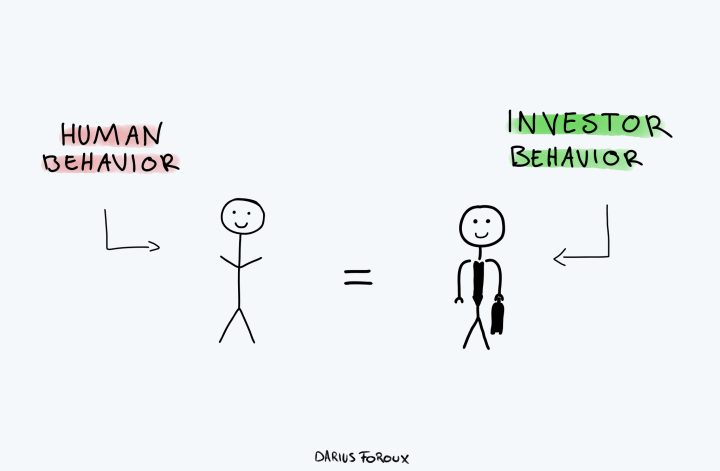Contrarian investing. It’s a term that may stir up images of investors who take unnecessary risks by pumping huge sums into an untested and unproven investment.
Contrarian investors are often mistaken for risk-takers. But that’s not the case. Most people never think about it, but Warren Buffett is also a contrarian investor.
What does contrarian investing even mean? And more importantly, how can you apply its principles to your own investment strategy?
What it means to be a contrarian investor
Put simply, contrarian investors go against current market trends. They might buy when others are selling and sell when others are buying.
A good example is the fourth quarter of 2022, the year of The Great Inflation.1Source: CNBC As the S&P 500 and Nasdaq 100 were in bear market territory, the sentiment was negative. Everyone seemed to sell.
Most pundits believed that inflation would stay high and that interest rates would also be high for a long time. But from the start of 2023, we started seeing economic and market conditions improve.
The investors who bought stocks in 2022 were contrarians. The investors who sold were following the herd.
Contrarian investing is based on the belief that herd behavior often leads to overpricing or underpricing of assets, creating opportunities for profit.
Lessons from famous contrarian investors
One of the most famous contrarian investors of all time is Warren Buffet who famously said:
“Be fearful when others are greedy and greedy when others are fearful.”
Just because Buffett looks like a calm individual, most people assume his investing strategy is not contrarian. After all, his approach seems so simple: Buy undervalued companies and hold on to them for a long time.
But the act of identifying undervalued companies is by definition contrarian. After all, a company won’t be undervalued if most people actually believe its accurate worth.
Buffett has been one of the best at spotting undervalued companies and investing in them when others are selling or holding.
Another famous contrarian investor is Sir John Templeton, founder of the Templeton Growth Fund.
Templeton started his Wall Street career in 1938 and ended up becoming one of the best stock pickers of his time. Templeton’s strategy involved looking for nations, industries, and companies that were hitting rock bottom. He searched for “points of maximum pessimism.”
When the war broke out in Europe in 1939, he borrowed some cash to buy 100 shares each in 104 companies going for a dollar or less per share, including 34 that were going bankrupt. Turns out, only four of those companies turned out to be worthless. And Templeton made big profits on the others.
By identifying companies that had real potential to get back up, Templeton achieved significant returns when these companies’ stocks eventually rebounded. As Templeton once said:
“People are always asking me where the outlook is good, but that’s the wrong question… The right question is: ‘Where is the outlook most miserable?'”
Contrarian investing strategies
So, how do you put contrarian investing into practice? Here are a few strategies you can look into:
1. Value Investing
The investing strategy that started with Benjamin Graham. It’s about buying stocks that are undervalued by the market. Contrarian investors look for companies with strong fundamentals that are currently out of favor with the market.
Some of the best books on value investing are The Intelligent Investor by Graham himself. Another book I recommend is Berkshire Hathaway Letters to Shareholders by Warren Buffett, edited by Max Olson.
2. Distressed Investing
This involves investing in companies that are in financial distress or bankruptcy. Think about Sir John Templeton and his strategy. While risky, these investments can yield high returns if the company recovers.
Howard Marks is someone who made a lot of money with distressed investing. I highly recommend his book, Mastering The Market Cycle. Another book I recommend is Richer, Wiser, Happier by William Green. In the book, Green talks about the strategies and personalities of various investors. It’s always advisable to learn from the best investing minds.
3. Sector Rotation
This strategy involves moving investments from one industry sector to another in anticipation of market cycle changes. Some common sectors that investors rotate are energy, autos, and consumer staples because these consist of companies that are highly sensitive to the state of the economy.
Peter Lynch was great at this strategy. He famously invested in companies such as Hertz and Ford when they were facing major economic challenges, but he correctly predicted that these companies would recover and generate significant profits.
The key, according to Lynch, is to invest only in companies or industries you understand. That’s the main idea of his bestselling book, One Up on Wall Street; which encourages ordinary investors to invest in what they know, when everyone else is investing out of hype.
4. Short Selling
This is a strategy where investors bet against a stock, hoping to profit when its price falls. You can borrow shares through a stock broker, sell them, and buy them back at a lower price. Famous short-sellers include Jim Chanos, George Soros, and Jesse Livermore.
I actually featured Livermore in my latest book, The Stoic Path to Wealth. Livermore’s life and investing strategy allowed him to make and lose large fortunes throughout his lifetime. Both his life and investment decisions are interesting to study if you want to get into the stock market.
5. Holding Forever
This is a controversial thing to say in an article about contrarian investing. But in my experience, buying an S&P 500 index fund with the intention of holding it forever also goes against the herd. You don’t have to be an active investor to be a contrarian. The average investor holds onto a stock for 5.5 months!2Source: Yahoo Finance If you hold on for decades, you’re truly in a special club.
This is a strategy I also talk about in my book, and I live by it. It has helped me create a 7-figure investing portfolio.
In a way, all successful investors are contrarian because they outperform the market.
They don’t follow the herd; they carve their own path. And this principle doesn’t just apply to investing—it applies to life.
Whether it’s deciding on a career, choosing a place to live, or even picking an investing strategy; contrarian decisions tend to have the most rewarding outcomes.
Don’t be afraid to go against the herd. You might just find that doing so is the most profitable choice.




